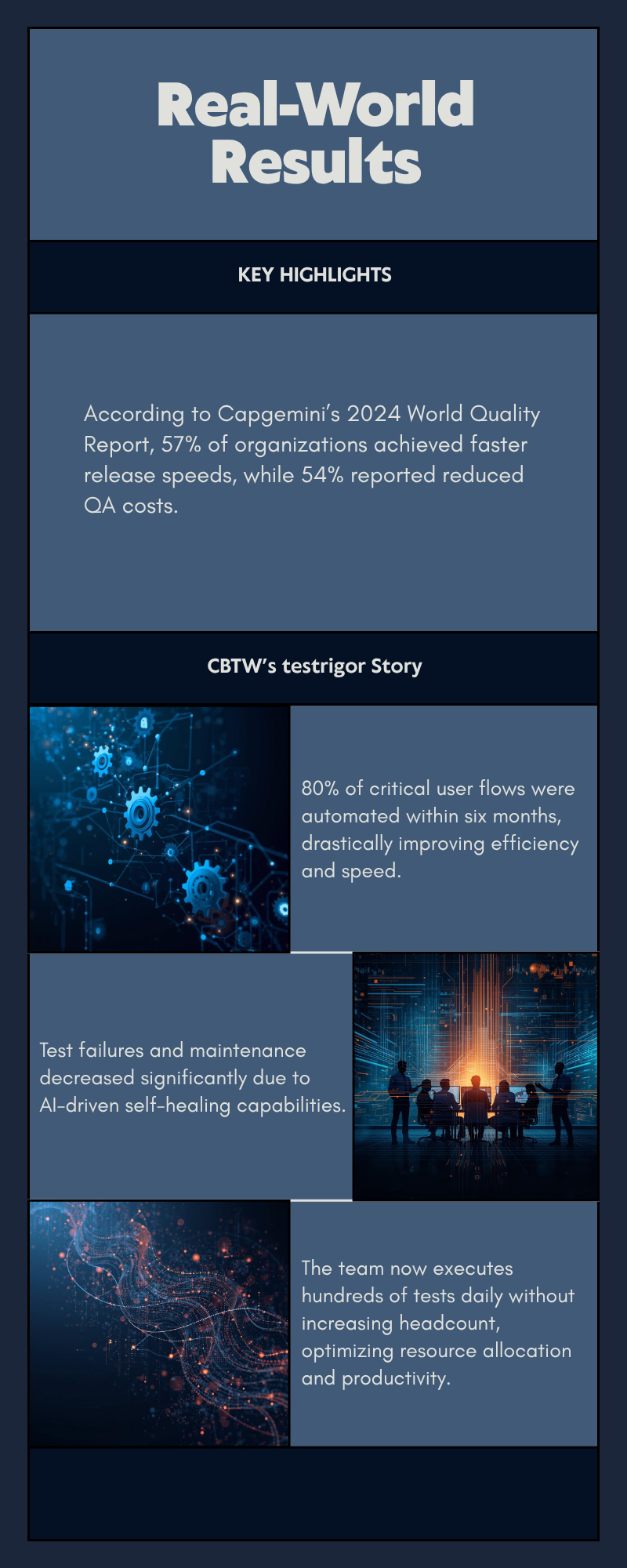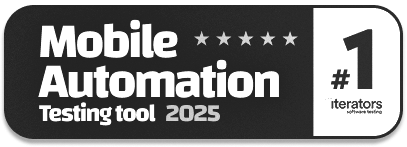80% Test Automation in 6 Months: How CBTW Scaled QA
|
|
Modern software teams deliver faster than ever, but QA often lags and may seem like a bottleneck for faster delivery. Most organizations rely on either manual execution or fragile, code-heavy automation frameworks that require specialized skills to create and maintain. This results in slower cycles, brittle test suites, and QA struggling to keep pace with DevOps delivery. The role of gen-AI-powered intelligent test automation tools is immense in this regard.
In this article, we will see how testRigor is helping organizations such as CBTW by weaving quality into delivery with ease and speed.
Why Traditional Automation Falls Short

While traditional test automation has long been seen as a way to speed up QA, in reality, it often introduces new bottlenecks and inefficiencies. Let us see the most important ones here:
- Dependency on Automation Engineers: This is a core issue. Most automation strategies require specialized QA automation engineers to design, implement, and maintain test scripts. This creates a dependency on skilled people, making QA progress contingent on a limited pool of technical experts.
- Fragile and Brittle Tests: Traditional automated tests are tightly coupled to specific UI elements and their locators. Even minor changes, such as an updated button label, a modified location on the page, or a change in test data, may result in test failures. And then, QA teams spend significant time finding the cause and fixing brittle tests instead of advancing coverage or improving quality. This causes a stall in the test automation process, and the dependency on manual effort stays.
- Maintenance Overhead: Over time, maintaining a growing suite of scripts can become a full-time job. Therefore, it diverts effort, time, and cost away from strategic testing initiatives and thus slows release cycles and impacts the quality of the product.
- Exclusion of Manual Testers: Traditional approaches also exclude manual testers and domain experts who may lack coding skills but possess deep product knowledge. This exclusion limits collaboration, reduces test quality, and increases the gap between business requirements and automated coverage. All of this just because of one reason: they lacked programming or technical skills to write test scripts.
- Integration Gaps: According to GitLab’s 2024 DevSecOps survey, only 15% of QA teams are fully integrated into DevOps pipelines. And test execution time is still cited as a major delivery bottleneck. Traditional automation, therefore, often fails to walk in tandem with modern software delivery demands.
How testRigor Shifts the Model
Intelligent testing tools like testRigor redefine QA by completely removing the dependency on code. Test cases are written in plain English and powered by Gen AI, AI context, Natural Language Processing (NLP), Vision AI, and other advanced algorithms. As a result, QA becomes more inclusive, scalable, and resilient for teams of all sizes.
- Natural Language Automation: Anyone in the team, including manual testers and non-technical team members, can easily create, execute, and maintain test cases in plain English. Without writing a single line of code, you can even just describe the app or feature, and testRigor can generate test cases for you using Gen AI. This empowers cross-functional collaboration, supports test creation, and removes bottlenecks associated with automation frameworks. Also, this feature helps to utilize the domain knowledge of BAs, manual testers, and other stakeholders who have very good hands-on experience with the application but do not have the required coding skills to write test scripts for the traditional testing frameworks. Read all the easy ways to generate or create test cases here: All-Inclusive Guide to Test Case Creation in testRigor.
- Gen AI-driven Stability: With intelligent self-healing capabilities, testRigor automatically adapts tests when applications, features, and UI elements change. This drastically minimizes the number of broken tests and helps teams maintain near-zero test maintenance, enabling them to focus on delivering quality rather than fixing flaky scripts. This is the most important feature as many of testRigor’s customers have affirmed that they have saved months of maintenance effort just because of the self-healing capabilities of testRigor.
- Cross-platform Coverage: Achieve true end-to-end testing across web, mobile, desktop, mainframes, databases, APIs, LLMs, AI-driven features, and chatbots, all without complex setup or the need to integrate multiple tools. testRigor provides a unified platform for seamless test execution.
- Scalability: Organizations can scale QA efforts rapidly without hiring large teams of automation engineers. By simplifying test creation and maintenance, testRigor helps teams achieve faster releases, broader coverage, and higher productivity at a fraction of the traditional cost.
Real-World Results

In one case, a digital banking client of CBTW was using only manual QA to support weekly releases. By adopting AI in testing, the team started writing tests in plain English:
- 80% of critical user flows were automated in just six months.
- Test failures dropped because of AI-driven self-healing.
- The team now runs hundreds of tests daily across environments without adding headcount.
Across industries such as financial services, logistics, and software, similar results are being seen after adopting AI-driven QA. According to Capgemini’s 2024 World Quality Report:
- 57% of organizations cited faster release speed from AI-driven QA.
- 54% reported reduced QA costs.
The Outcome: QA at the Speed of Delivery
With testRigor, Quality Assurance evolves from a specialized, engineer-driven function into a collaborative, team-wide capability. By empowering everyone, regardless of technical background, to participate in test creation and execution, organizations can break down traditional silos. It builds a culture where quality is everyone’s responsibility. The benefits are clear:
- Broader ownership of quality across teams. Product managers, manual testers, business analysts, and developers can all contribute to building and maintaining tests in plain English. As a result, communication improves, testing becomes more transparent, and quality considerations are integrated earlier and more deeply into the development lifecycle.
- Faster delivery cycles without compromising quality. Because testRigor enables rapid test creation and drastically reduces the time spent on maintenance, teams can align their QA processes with the pace of modern continuous integration and deployment practices.
- Significant reduction in maintenance effort. Self-healing capabilities and AI-driven stability ensure that tests remain robust even as applications evolve. This frees teams from the endless cycle of fixing broken scripts.
- A QA function aligned with the speed and agility of modern software delivery. Instead of slowing releases, QA accelerates them—enabling organizations to innovate faster, deliver with confidence, and maintain a consistently high standard of quality across all platforms and technologies.
CBTW’s testRigor Story
CBTW has shared its experience using testRigor to enhance QA efficiency publicly. We appreciate their collaboration and continued focus on advancing software quality together. Read their LinkedIn article: The Future of QA Engineers Is Codeless – And It’s Already Here.
Their experience highlights how codeless automation helps reduce code dependencies, widen testing participation, and align QA with faster delivery cycles. CBTW observed that AI-powered, codeless tools are shaping the future of QA, supporting broader accessibility and consistency in testing. This reflects an industry-wide movement toward balancing speed, scalability, and quality.
Conclusion
CBTW’s adoption of testRigor shows how modern QA practices can evolve to meet delivery demands. By moving to a codeless framework, they achieved faster automation coverage and reduced maintenance efforts.
The collaboration illustrates how AI-driven, codeless testing can strengthen QA stability and scalability, helping teams integrate quality more effectively across development.
| Achieve More Than 90% Test Automation | |
| Step by Step Walkthroughs and Help | |
| 14 Day Free Trial, Cancel Anytime |












